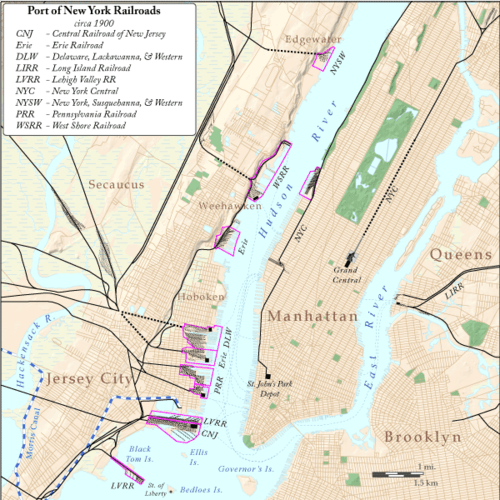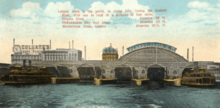Exchange Place (PRR station)
Pennsylvania Railroad Station | |||||||||||||||
|---|---|---|---|---|---|---|---|---|---|---|---|---|---|---|---|
_pg123_PENNSYLVANIA_RAILROAD%2C_JERSEY-CITY_STATION.jpg) Pennsylvania Railroad's Jersey City Station, 1893 | |||||||||||||||
| Coordinates | 40°42′59″N 74°01′57″W / 40.71648°N 74.03238°WCoordinates: 40°42′59″N 74°01′57″W / 40.71648°N 74.03238°W | ||||||||||||||
| Operated by | Pennsylvania Railroad (PRR) | ||||||||||||||
| Connections |
| ||||||||||||||
| History | |||||||||||||||
| Opened | 1834 | ||||||||||||||
| Closed | 1961 | ||||||||||||||
| Services | |||||||||||||||
| |||||||||||||||
| Location | |||||||||||||||
 Pennsylvania Railroad Station Location on a map showing the railroads in the New York City area ca 1900 | |||||||||||||||
_pg124_PENNSYLVANIA_RAILROAD_DEPOT%2C_JERSEY_CITY%2C_INTERIOR_OF_TRAIN-HOUSE.jpg)


The Pennsylvania Railroad Station was the intermodal passenger terminal for the Pennsylvania Railroad's (PRR) vast holdings on the Hudson River and Upper New York Bay in Jersey City, New Jersey. By the 1920s the station was called Exchange Place in response to local nomenclature. The rail terminal and its ferry slips were the main New York City station for the railroad until the opening in 1910 of New York Penn Station, made possible by the construction of the North River Tunnels. The terminal was located on Paulus Hook, which in 1812 became the landing of the first steam ferry service in the world, and to which rail service began in 1834. Train service to the station ended in November 1961 and demolition of the building complex was completed in 1963. Part of the former terminal complex is now the PATH system's Exchange Place Station.
The station was one of five passenger railroad terminals that lined the western shore of the Hudson River during the 19th and 20th centuries, the others being Weehawken, Hoboken, Pavonia, and Communipaw.
History

Ferry service between Paulus Hook and Manhattan began in 1812, the first steam ferry service in the world.[1] The New Jersey Rail Road and Transportation Company opened a rail line from Paulus Hook, then part of the newly incorporated City of Jersey, west to Newark in 1834.[2] The PRR acquired the railroad in 1871 and replaced the terminal in 1876 and yet again in 1888-1892.[3] Passengers could move directly between the trains and ferries without going outside. The railroad referred to the location simply as "Jersey City," and if necessary to distinguish it from other railroads' terminals, as the Pennsylvania station.
In the 1870s the PRR began exploring ways to improve rail access between New Jersey and New York (see New York Tunnel Extension). A number of route realignments produced a straighter track, with the final realignment, a new passenger line from Harrison to east of the new bridge (now the PATH Lift Bridge) over the Hackensack River, opening in 1900.[4] (The old freight line still exists as part of the Passaic and Harsimus Line.)
The 1910 opening of the North River Tunnels under the Hudson River led to a substantial reduction in PRR traffic at Exchange Place. On October 1, 1911 the Hudson and Manhattan Railroad, a rapid transit system (now called Port Authority Trans Hudson or PATH), began operating over the PRR line west of Waldo Yard, connecting with the new Manhattan Transfer station at Harrison.[5] The Lehigh Valley Railroad, which had operated its Black Diamond train service from Buffalo, New York since 1896, ended service to Exchange Place in 1913.[6] Ferry service at Exchange Place ended in 1949. The last PRR passenger train used the branch on November 17, 1961.[7] PATH continues to use the line through Bergen Hill to the Journal Square Transportation Center and onward to Newark Penn Station.
.jpg)
The Exchange Place terminal fell into gradual disuse.[8] The last of the buildings of the complex, along with the elevated portion of the rail line, were demolished in 1963.[9] Part of the former terminal complex is now the PATH system's Exchange Place Station and the Harborside Financial Center, while the ferry slips have been replaced with J. Owen Grundy Waterfront Park. Hudson-Bergen Light Rail maintains two stations in the district while ferries are now served by the Paulus Hook Ferry Terminal.
- See also Exchange Place as transportation hub
See also
- Exchange Place (Jersey City)
- Exchange Place (HBLR station) (Hudson-Bergen Light Rail)
- Greenville Yard (Port Jersey)
- Harsimus Stem Embankment
- List of ferries across the Hudson River to New York City
- Railroad terminals serving New York City
- Timeline of Jersey City area railroads
References
- ↑ Cudahy, Brian J. (1990). Over and Back: The History of Ferryboats in New York Harbor. New York: Fordham University Press. pp. 20–24, 360, 362. ISBN 0-8232-1245-9.
- ↑ "PRR Chronology, 1834." June 2004 Edition.
- ↑ Condit, Carl (1980). The Port of New York. A History of the Rail and Terminal System from the Beginnings to Pennsylvania Station (Volume 1). University of Chicago Press. pp. 46–52,152–168. ISBN 978-0-226-11460-6.
- ↑ "PRR Chronology, 1900." March 2005 Edition.
- ↑ "PRR Chronology, 1911." March 2005 Edition.
- ↑ "The 'Black Diamond' on the Lehigh". Railway and Locomotive Engineering. New York: Angus Sinclair Co. 20 (12): 525. 1907.
- ↑ "PRR Chronology, 1961." June 2004 Edition.
- ↑ Cudahy, Brian J. (2002). Rails Under the Mighty Hudson (2nd ed.). New York: Fordham University Press. p. 54. ISBN 0-8232-2190-3. OCLC 48376141.
- ↑ "PRR Chronology, 1963." June 2004 Edition.
External links
- Exchange Place - "Jersey City: Past and Present" (New Jersey City University)
- Photo of depot as seen from the Hudson River
- Jersey City Landmarks Committee: Harsimus Branch Embankment and Pennsylvania Main Stem Elevated
- Photo of Exchange Place facing terminal and ferry slips, c. 1905
- PRR system map 1899
- Travellers description of cut 1800s